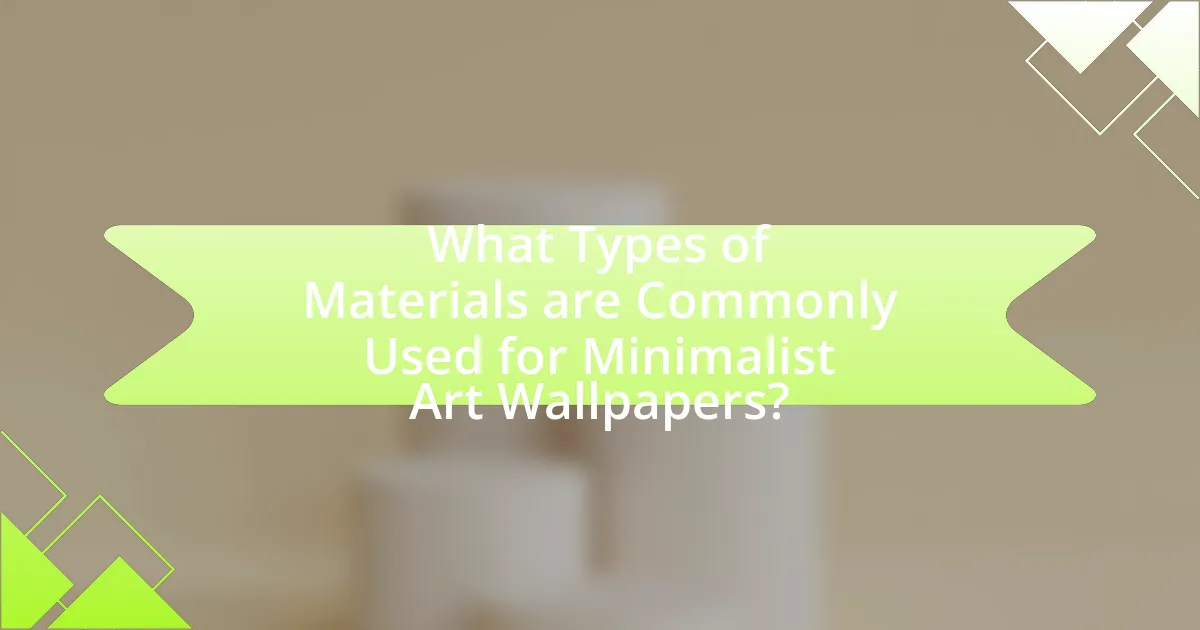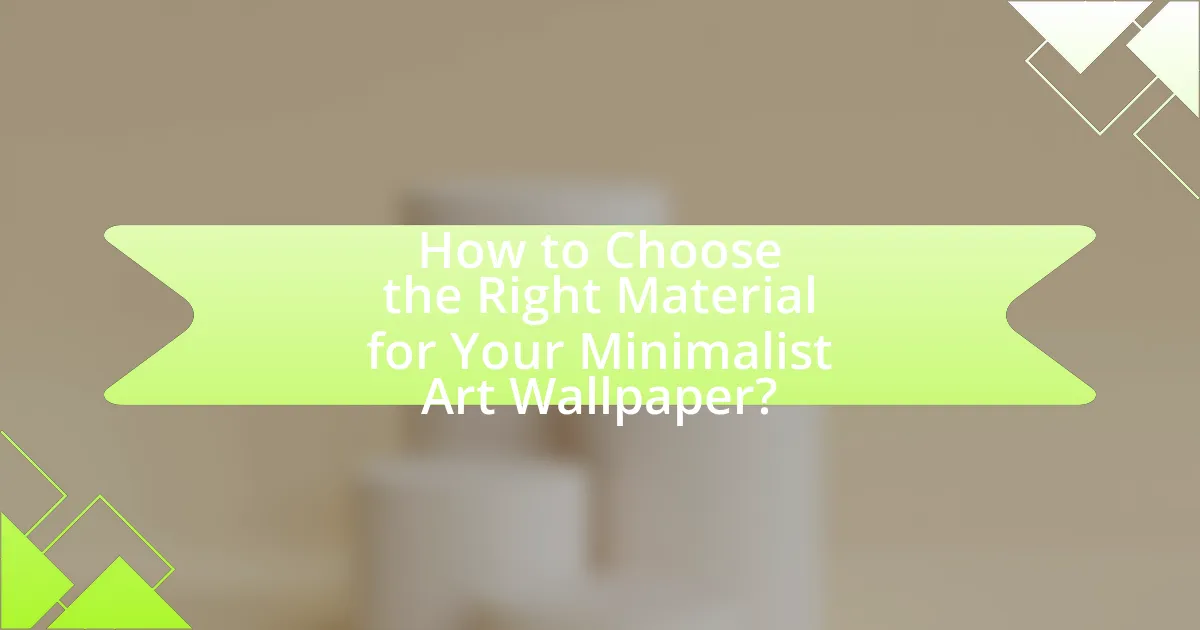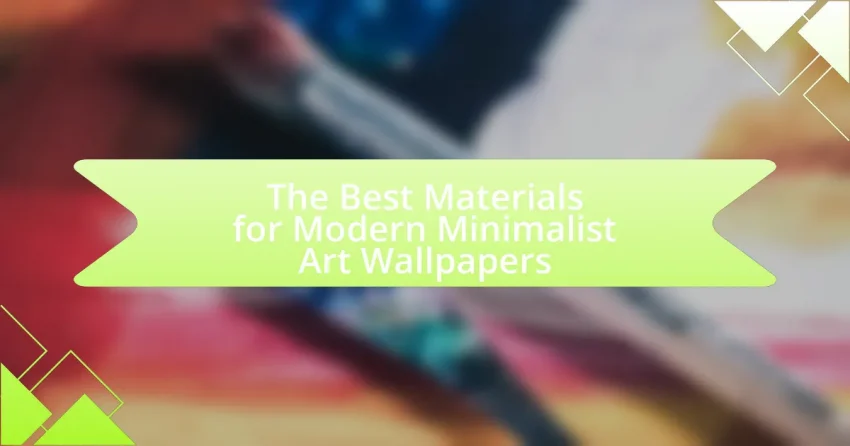The article focuses on the best materials for modern minimalist art wallpapers, highlighting vinyl, non-woven fabric, and paper as the primary options. It examines how different materials impact the aesthetic qualities of wallpapers, including texture, color saturation, and visual appeal. The discussion includes the durability and maintenance requirements of each material, as well as their environmental sustainability. Additionally, the article addresses the importance of material choice in enhancing minimalist design principles and provides guidance on selecting the right wallpaper based on room usage and budget considerations.

What are the Best Materials for Modern Minimalist Art Wallpapers?
The best materials for modern minimalist art wallpapers include vinyl, non-woven fabric, and paper. Vinyl is durable, easy to clean, and resistant to moisture, making it ideal for high-traffic areas. Non-woven fabric offers breathability and ease of installation, allowing for quick removal and repositioning without damaging walls. Paper wallpapers provide a classic aesthetic and are often more environmentally friendly, though they may require more care in maintenance. These materials are favored for their ability to enhance the simplicity and elegance characteristic of minimalist design.
How do different materials impact the aesthetic of minimalist art wallpapers?
Different materials significantly influence the aesthetic of minimalist art wallpapers by altering texture, color saturation, and overall visual impact. For instance, paper wallpapers provide a smooth, matte finish that enhances subtle color variations, while vinyl wallpapers offer a glossy surface that can intensify colors and create a more vibrant appearance. Additionally, fabric wallpapers introduce a tactile quality that can soften the overall look, making spaces feel warmer and more inviting. The choice of material also affects light reflection; for example, metallic finishes can add a contemporary edge by reflecting light, thus creating dynamic visual effects. These material characteristics directly contribute to the minimalist art aesthetic by either emphasizing simplicity and elegance or introducing complexity through texture and light interaction.
What are the visual characteristics of popular wallpaper materials?
Popular wallpaper materials exhibit distinct visual characteristics that influence their aesthetic appeal. Vinyl wallpaper is known for its durability and can feature high-gloss finishes or textured surfaces, providing a modern look. Paper wallpaper, often printed with intricate designs, offers a softer, more traditional appearance, while fabric wallpaper adds warmth and depth with its rich textures. Non-woven wallpaper combines the benefits of both paper and vinyl, allowing for easy application and removal, and often features bold patterns or colors. Each material’s visual characteristics contribute to the overall ambiance of a space, making them suitable for various design styles.
How does texture influence the perception of minimalist art wallpapers?
Texture significantly influences the perception of minimalist art wallpapers by adding depth and tactile quality, which can enhance visual interest without overwhelming simplicity. In minimalist art, where the focus is on clean lines and limited color palettes, texture can create a contrast that draws attention and invites closer inspection. Research indicates that textures can evoke emotional responses and alter the viewer’s experience; for instance, a study published in the Journal of Environmental Psychology found that textured surfaces can increase feelings of warmth and comfort, making the artwork more engaging. Thus, the incorporation of varied textures in minimalist wallpapers not only complements the aesthetic but also enriches the viewer’s interaction with the art.
Why is material choice crucial in modern minimalist art?
Material choice is crucial in modern minimalist art because it directly influences the aesthetic and conceptual clarity of the artwork. In minimalist art, the focus is on simplicity and the essence of form, which means that the materials used must enhance these qualities rather than detract from them. For instance, artists often select materials like metal, glass, or high-quality paper to achieve a clean, refined look that aligns with minimalist principles. The use of specific materials can also evoke particular emotions or responses from the viewer, reinforcing the artwork’s intended message. Additionally, the durability and texture of materials can impact the overall perception of the piece, making the choice of material a fundamental aspect of the artistic expression in modern minimalist art.
What role does sustainability play in selecting wallpaper materials?
Sustainability plays a crucial role in selecting wallpaper materials by influencing choices towards eco-friendly options that minimize environmental impact. Sustainable wallpaper materials often include recycled content, non-toxic inks, and biodegradable substrates, which reduce waste and harmful emissions during production. For instance, wallpapers made from natural fibers like bamboo or organic cotton are renewable resources that contribute to a lower carbon footprint. Additionally, the use of water-based adhesives and inks further enhances the sustainability of wallpaper products, aligning with growing consumer demand for environmentally responsible home decor.
How do different materials affect the durability of minimalist art wallpapers?
Different materials significantly influence the durability of minimalist art wallpapers. For instance, vinyl wallpapers are highly resistant to moisture and wear, making them suitable for high-traffic areas, while paper-based wallpapers are more susceptible to damage from humidity and physical wear. Additionally, non-woven wallpapers combine durability with ease of installation and removal, as they are tear-resistant and breathable, preventing mold growth. Research indicates that vinyl wallpapers can last up to 15 years, while paper wallpapers may require replacement within 5 to 7 years due to their lower resilience. Thus, the choice of material directly correlates with the longevity and maintenance needs of minimalist art wallpapers.

What Types of Materials are Commonly Used for Minimalist Art Wallpapers?
Common materials used for minimalist art wallpapers include vinyl, non-woven fabric, and paper. Vinyl is popular due to its durability and ease of cleaning, making it suitable for high-traffic areas. Non-woven fabric offers breathability and is easy to install and remove, which is ideal for temporary designs. Paper wallpapers, while less durable, provide a wide range of textures and finishes, allowing for creative expression in minimalist designs. These materials are chosen for their aesthetic appeal and functional properties, aligning with the principles of minimalist art that emphasize simplicity and elegance.
What are the advantages of using vinyl for minimalist wallpapers?
Vinyl offers several advantages for minimalist wallpapers, including durability, ease of maintenance, and versatility in design. The durability of vinyl makes it resistant to wear and tear, ensuring that the wallpaper maintains its appearance over time, which is essential for minimalist aesthetics that rely on clean lines and simplicity. Additionally, vinyl is easy to clean, allowing for quick removal of stains or dirt, which is particularly beneficial in high-traffic areas. Its versatility enables a wide range of textures and finishes, accommodating various minimalist styles while providing a smooth surface that enhances the overall visual appeal.
How does vinyl compare to paper in terms of maintenance?
Vinyl requires less maintenance compared to paper. Vinyl is water-resistant and can be easily wiped clean, making it suitable for high-traffic areas and environments prone to moisture. In contrast, paper is more susceptible to damage from water, dirt, and wear, requiring more careful handling and regular cleaning to maintain its appearance. Additionally, vinyl’s durability means it can last longer without needing replacement, while paper may fade or tear more quickly, necessitating more frequent upkeep.
What design options are available with vinyl wallpapers?
Vinyl wallpapers offer a variety of design options, including solid colors, patterns, textures, and printed images. These designs can range from minimalist geometric shapes to intricate floral motifs, catering to diverse aesthetic preferences. Additionally, vinyl wallpapers can mimic natural materials such as wood or stone, providing a versatile choice for interior decor. The durability and moisture resistance of vinyl also allow for designs suitable for high-humidity areas like kitchens and bathrooms, making them practical as well as stylish.
What makes fabric a popular choice for minimalist art wallpapers?
Fabric is a popular choice for minimalist art wallpapers due to its texture and versatility, which enhance the aesthetic appeal of minimalist designs. The natural fibers in fabric can create a soft, inviting atmosphere, aligning with the minimalist philosophy of simplicity and functionality. Additionally, fabric wallpapers can be printed with high-resolution images, allowing for intricate designs that maintain clarity and detail, which is essential in minimalist art. The ability to easily change or update fabric wallpapers also supports the evolving nature of minimalist decor, making it a practical option for homeowners seeking a fresh look without significant commitment.
How does fabric contribute to the overall ambiance of a space?
Fabric significantly contributes to the overall ambiance of a space by influencing its texture, color, and warmth. The choice of fabric can enhance the aesthetic appeal, creating a cohesive design that aligns with the intended atmosphere. For example, soft textiles like velvet or cotton can evoke comfort and relaxation, while sleek materials such as silk or linen can impart a sense of elegance and sophistication. Studies have shown that the tactile quality of fabrics affects human emotions and perceptions; for instance, a study published in the Journal of Environmental Psychology indicates that soft textures can promote feelings of calmness and well-being. Thus, the strategic use of fabric in a space not only enhances visual appeal but also plays a crucial role in shaping the emotional experience of its occupants.
What are the care requirements for fabric wallpapers?
Fabric wallpapers require gentle cleaning and maintenance to preserve their appearance and longevity. Regular dusting with a soft cloth or vacuuming with a brush attachment helps remove dust and dirt. For stains, a mild detergent mixed with water can be applied using a soft sponge, ensuring not to saturate the fabric. It is essential to avoid harsh chemicals and abrasive materials, as they can damage the fabric. Additionally, fabric wallpapers should be kept away from direct sunlight to prevent fading. These care practices are crucial for maintaining the aesthetic and durability of fabric wallpapers.

How to Choose the Right Material for Your Minimalist Art Wallpaper?
To choose the right material for your minimalist art wallpaper, prioritize options that enhance simplicity and elegance, such as vinyl, non-woven fabric, or paper. Vinyl wallpaper is durable and easy to clean, making it suitable for high-traffic areas, while non-woven fabric offers breathability and easy installation. Paper wallpaper, although less durable, provides a classic aesthetic that aligns well with minimalist designs. Selecting the appropriate material depends on the intended use, maintenance preferences, and desired visual impact, ensuring that the wallpaper complements the minimalist theme effectively.
What factors should you consider when selecting wallpaper materials?
When selecting wallpaper materials, consider durability, texture, ease of installation, and maintenance. Durability is crucial as it determines how well the wallpaper withstands wear and tear; for instance, vinyl wallpapers are known for their resilience and moisture resistance, making them suitable for high-traffic areas. Texture impacts the aesthetic appeal and can enhance the minimalist design; smooth finishes often complement modern styles. Ease of installation is important for DIY projects; peel-and-stick options simplify the process. Lastly, maintenance is vital; washable wallpapers allow for easy cleaning, which is beneficial in maintaining a fresh look over time.
How does the intended room usage influence material choice?
Intended room usage significantly influences material choice for wallpapers, as different environments require specific characteristics in materials. For example, wallpapers intended for high-moisture areas like bathrooms must be made from water-resistant materials such as vinyl or treated paper to prevent mold and deterioration. Conversely, wallpapers for living rooms may prioritize aesthetics and texture, allowing for the use of fabric or paper that enhances visual appeal without the need for moisture resistance. Additionally, durability is crucial in high-traffic areas like hallways, where materials like vinyl or non-woven options are preferred for their resilience. These considerations ensure that the chosen wallpaper not only complements the room’s design but also meets functional requirements based on its intended use.
What budget considerations should be taken into account?
When considering a budget for modern minimalist art wallpapers, it is essential to account for material costs, installation expenses, and maintenance requirements. Material costs can vary significantly based on the type of wallpaper chosen, such as vinyl, fabric, or paper, with vinyl typically being more durable and easier to clean, thus potentially reducing long-term maintenance costs. Installation expenses should also be factored in, as professional installation may be necessary for certain materials, which can add to the overall budget. Additionally, ongoing maintenance, including cleaning and potential repairs, should be considered to ensure the longevity of the wallpaper.
What are some tips for maintaining minimalist art wallpapers?
To maintain minimalist art wallpapers, regularly clean them with a soft, dry cloth to remove dust and prevent buildup. This method preserves the artwork’s clarity and prevents discoloration. Additionally, avoid using harsh chemicals or abrasive materials, as they can damage the wallpaper’s surface. For long-lasting results, ensure the wallpaper is installed in a low-humidity environment to prevent peeling or warping, as moisture can compromise the integrity of the materials used. Regular inspections for signs of wear or damage allow for timely repairs, ensuring the wallpaper remains visually appealing and intact.
How can you ensure the longevity of your chosen wallpaper material?
To ensure the longevity of your chosen wallpaper material, select high-quality, durable materials such as vinyl or non-woven fabric, which are resistant to wear and tear. These materials are designed to withstand moisture, fading, and tearing, making them ideal for long-term use. For instance, vinyl wallpapers can last up to 15 years or more when properly maintained, as they are washable and resistant to stains. Additionally, applying a protective coating can enhance durability, while proper installation and maintenance, including regular cleaning and avoiding excessive moisture, further contribute to the wallpaper’s lifespan.
What cleaning methods are best for different wallpaper types?
Vinyl wallpaper can be cleaned with a damp cloth and mild soap, as it is water-resistant and durable. For fabric wallpaper, a vacuum with a brush attachment is recommended to remove dust, while spot cleaning with a gentle fabric cleaner can address stains. Paper wallpaper requires a dry cleaning method, such as using a soft brush or a dry sponge, since moisture can damage it. Textured wallpaper may benefit from a vacuum or a soft brush to avoid damaging the surface. These methods are effective because they align with the material properties of each wallpaper type, ensuring longevity and maintaining appearance.
